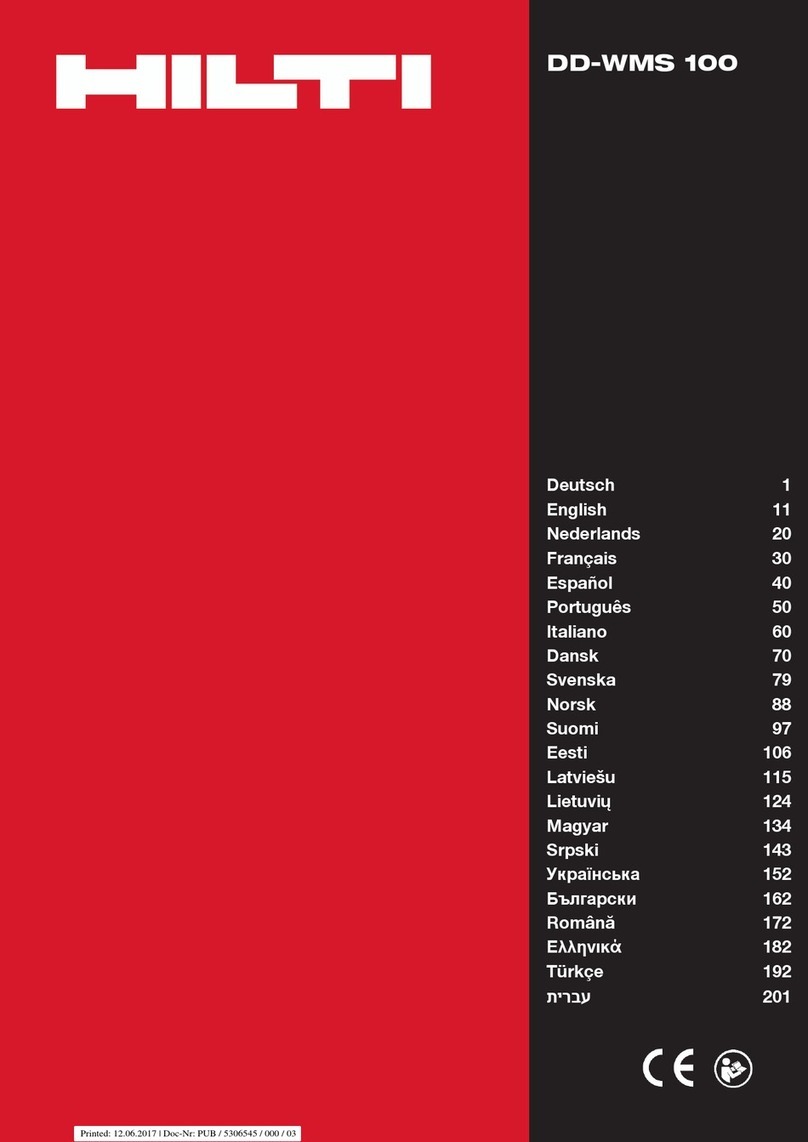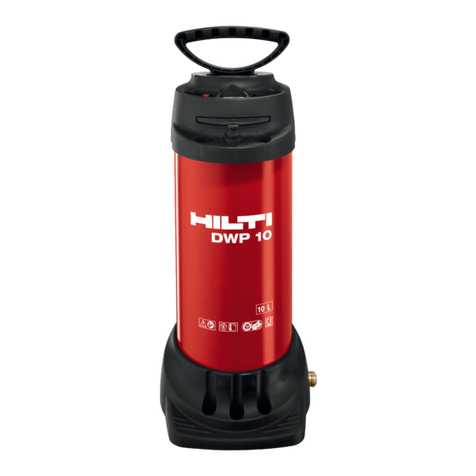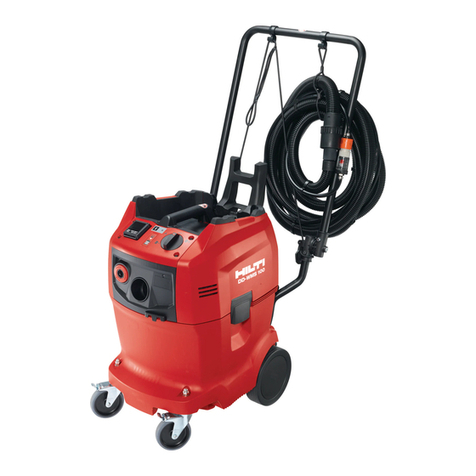6
– Connect the unit to the mains supply. Use the supply
cord with the built-in GFCI ground fault interruptor
(supplied with the diamond core drilling machine).
Insert the keyed plug in the socket as described above.
Insert the mains plug in the mains socket.
– Switch on the ground fault interruptor by pressing
the green button. The self-test function of the unit is
then activated. All warning lamps light briefly and an
acoustic signal is emitted.
– Test the GFCI for correct functionality. To do this,
press the black test button. The ON indicator on
the unit must extinguish. After testing, switch on again
by pressing the green button.
– Switch on the unit by turning the ON / OFF switch in
a clockwise direction as far as it will go. It then takes
about 20 seconds for the internal parts of the system
to fill with water. During this time, the water supply
system is not fully operational. Subsequently, the
green ON indicator lights to show that the unit is ready
for use.
– Start the water supply system by operating the switch
on the DD EC-1 diamond core drilling machine. Adjust
the water volume as desired by turning the regulator
on the diamond core drilling machine and begin drilling
(please refer to the operating instructions for the DD
EC-1 diamond core drilling machine).
– Automatic filter flushing begins (takes about 15 to 20
seconds) when the switch on the DD EC-1 diamond
core drilling machine is not operated for several sec-
onds. The unit supplies no water during this time.
– After completion of the filter flushing procedure, the
unit is again ready for use and the next drilling oper-
ation can be started (ready mode).
– Stand-by mode: If the switch on the diamond core
drilling machine is not pressed for a period of more
than 15 minutes, the unit automatically releases pres-
sure and enters stand-by mode. In this case, before
beginning the next drilling operation, the switch on
the diamond core drilling machine must be pressed
briefly in order to re-pressurise the unit. After a few
seconds, the unit is again ready to supply water.
Warning indicators
– Acoustic warning signal (without warning lamp): This
indicates inadequate water flow which could be caused
by incorrect adjustment of the regulator valve in man-
ual operation or other malfunctions (please refer to
the “Troubleshooting“ section).
– Water warning lamp (simultaneous acoustic warning
signal): This indicates inadequate water pressure. Could
be caused by the container being empty, blocked filter
or other malfunctions (see “Troubleshooting” section).
– Temperature warning lamp (simultaneous acoustic
warning signal): This indicates excessively high water
temperature. Stop using the system immediately (see
“Troubleshooting” section).
– Water level / slurry volume sight glass: This indicates
the drilling slurry level and the remaining quantity of
water in the container. It provides useful fault-finding
information in case of malfunctions and makes it pos-
sible to estimate the number of holes which can be
drilled before emptying and refilling. Due to widely
varying conditions (diameter, depth, etc.), it is not
possible to give an exact indication of the number of
holes which can be drilled.
Cleaning the container
– The container should be emptied and cleaned in the
following cases (it is generally recommended that the
main filter is cleaned at the same time):
– Malfunctions caused by the slurry level being too high
or the water level being too low (see “Troubleshoot-
ing” section).
– Unit is switched off permanently (e.g. at the end of
the working day).
– Remove the container from the housing and open
it as described above. Observe the safety rules.
– Dispose of the container contents in accordance with
and under observance of local regulations.
– Rinse out the remaining slurry and, if necessary,
remove dried-on remains. Wipe the inside of the sight
glass with a soft cloth. Clean the surfaces of the seals
on the container carefully .
– Clean the main filter (see below).
– Fill the container as described above, close it and then
insert it in the housing.
Regenerating the main filter
– Regeneration of the main filter is recommended in
the following situations:
– When malfunctions caused by blockage of the main
filter are experienced
– Each time the container is refilled
– Remove the container from the housing as described
above and open it. Observe the safety precautions.
– Unscrew the main filter from the cover. When doing
so, do not hold the filter by the ceramic body. Instead,
grip it only by the grip section on the underside of the
main filter (reduces risk of breakage) .
– Clean the main filter under running water, using the
sandpaper supplied, by rubbing it in a longitudinal
direction on all sides until the light colour of the ceram-
ic body reappears .
During this process, the outermost surface of the
ceramicbodyisrubbedoff.Thisregenerationproce-
dure can be repeated up to about 20 times until the
minimum wall thickness of the ceramic body is reached.
– Check the wall thickness of the ceramic body. The
main filter must be replaced as soon as the diameter
of the ceramic body reaches a minimum of 42 mm.
Failure to observe this point could result in cracking
or breakage of the ceramic body .
– Check the main filter. Replace it immediately if cracked
or broken. A defective main filter may cause damage
to the recycling unit and to the diamond core drilling
machine.
– Screw the main filter into the cover until resistance is
clearly felt. Then continue to turn the filter a further
45° (maximum). Screwing the filter in beyond this
Printed: 07.07.2013 | Doc-Nr: PUB / 5069615 / 000 / 00






























